What is a Net Promoter Score? [+ Guide to HubSpot's NPS survey tool]
Guest

How often do head to Google, social media, or other sources to check customer reviews before making a purchase?
If you’re like 91% of consumers, you regularly or occasionally check online product or service ratings before ever “Proceeding to Checkout” or hitting the “order” button.
Today's connected customer is sharing experiences with their networks more than ever, and the service experience your business provides is at the forefront of the conversation.
In fact, 9 in 10 Americans tell others about their service experiences for better or worse, and 69% of consumers are willing to spend more with a company that provides good customer service.
Gathering (and managing) overall customer sentiment is important because modern customers give a hoot about the service experiences they receive; so much so, that they're basing their decision to do business with your company based upon how they feel about these noteworthy CS experiences (which also often end up in your company reviews).
Understanding your customers helps you make sure your review "cheerleaders" continue to have positive things to say about you for customer acquisition purposes, yes. --(Did you know referrals are the #1 most common source of new leads?) -- But ensuring that individual customer continues to see your company in a positive light is also critically important in keeping them loyal to your brand and coming back for more.
So, just how important is keeping your current customers happy? Well,
- Acquiring new customers is six to seven times more expensive than retaining existing ones
- The average company sees 65% of their business coming from existing customers
- And, 72% of customers switched to a competitor after one bad service interaction
A 2022 state of service study also reported 71% of consumers said businesses that showed empathy in interactions during the pandemic was key in earning their loyalty, further solidifying the notion that personalized, human-centered service interactions create connections people crave and will remain loyal to, if provided to them.
The good news is that your customers are definitely accessible and will more than likely fill out a simple survey if you just ask. With 24/7 smartphone access to email or your website at any given time, customer service platforms like HubSpot's Service Hub have created tools to help companies efficiently gather customer feedback and react accordingly to any potential gaps in the service experiences before they ever head to Google or other review platforms to share every detail with the internet.
When you proactively and consistently ensure customer satisfaction by asking for, responding to, and acting upon honest feedback, it shows the customer you care, makes the them feel seen, and increases the likelihood that they’ll stay with your brand (and also recommend it to friends and family).
Cue: the Net Promoter Score (or NPS).
What is a Net Promoter Score (NPS)?
Net Promoter Score (or NPS) is a customer satisfaction benchmark that measures the likelihood that your customers recommend your business to friends on a scale of 1-10.
Rather than measuring specific benchmarks in individual customer interactions like customer satisfaction (CSAT) or customer effort scores, Net Promoter Scores measure overall customer sentiment about your brand.
(Companies may also gather Net Promoter Scores from their employees to gauge how satisfied or dissatisfied they are in working for said company, but for the purpose of today's post, we'll focus on NPS in customer-facing interactions.)
Gathering Net Promoter Score (NPS) data plays a key role in helping businesses to keep an open flow of communication with their customers, and helps teams attain a better, un-biased understanding of their customer experience.
When NPS data is collected regularly, companies are enabled to make informed and strategic decisions that keep their customer (and talent-facing) operations consistently improving and advancing to meet evolving needs.
How do you find your Net Promoter Score (NPS)?
As a modern consumer (or employee), you’ve probably encountered a question to the effect of something like: “On a scale of 0 to 10, how likely are you to recommend us to a friend?”
Asking this familiar question is a company’s first step in calculating their NPS, and this simple survey can be sent through a variety of channels including email, social media polls, or non-intrusive pop-up notifications on your website.
HubSpot's Service Hub NPS tool is an easy way to create, manage, and respond to email and website customer sentiment surveys. This user-friendly tool saves businesses time in otherwise manual, time-consuming tasks .
What are the 3 categories of NPS?
NPS survey respondents fall into one of three categories based on the rating they give your business
These categories and ratings include:
- NPS Promoters - Ratings between 9-10
- NPS Passives - Ratings between 7-8
- NPS Detractors - Ratings between 0-6
NPS Promoter:
NPS Promoters are your company’s biggest fans. They’re the ones who’ve given you a 9-out-of-10 or 10-out-of-10 overall satisfaction rating, and are likely to share their positive experiences with friends and family, and bring them along to your business’ doorstep.
NPS Passive:
NPS Passives tend to be your not-so-enthusiastic customers who offer scores between seven and eight. Their indifference isn’t necessarily positive or negative, but keep an eye on what they have to say, because there’s equal potential for them to become promoters or jump to your competitor for their next purchase.
NPS Detractor:
NPS Detractor ratings indicate that this person is at risk of taking their business (or employment) elsewhere. These dissatisfied individuals, who give ratings between 0-6, are also most likely to air their grievances about your company with their networks (especially if you don't acknowledge or work to resolve their problem with them personally).
What is Net Promoter Score formula and how do you calculate NPS?
Once you’ve gathered and organized ratings by promoters, passives and detractors, calculate your Net Promoter Score by subtracting the percentage of detractors from the percentage of promoters.
Specifically, the Net Promoter Score formula looks like this:
(# of Promoters/Total Number of Respondents) - (# of Detractors/Total Number of Respondents)
= Net Promoter Score (NPS)
Our friends at HubSpot also offer a stellar example:
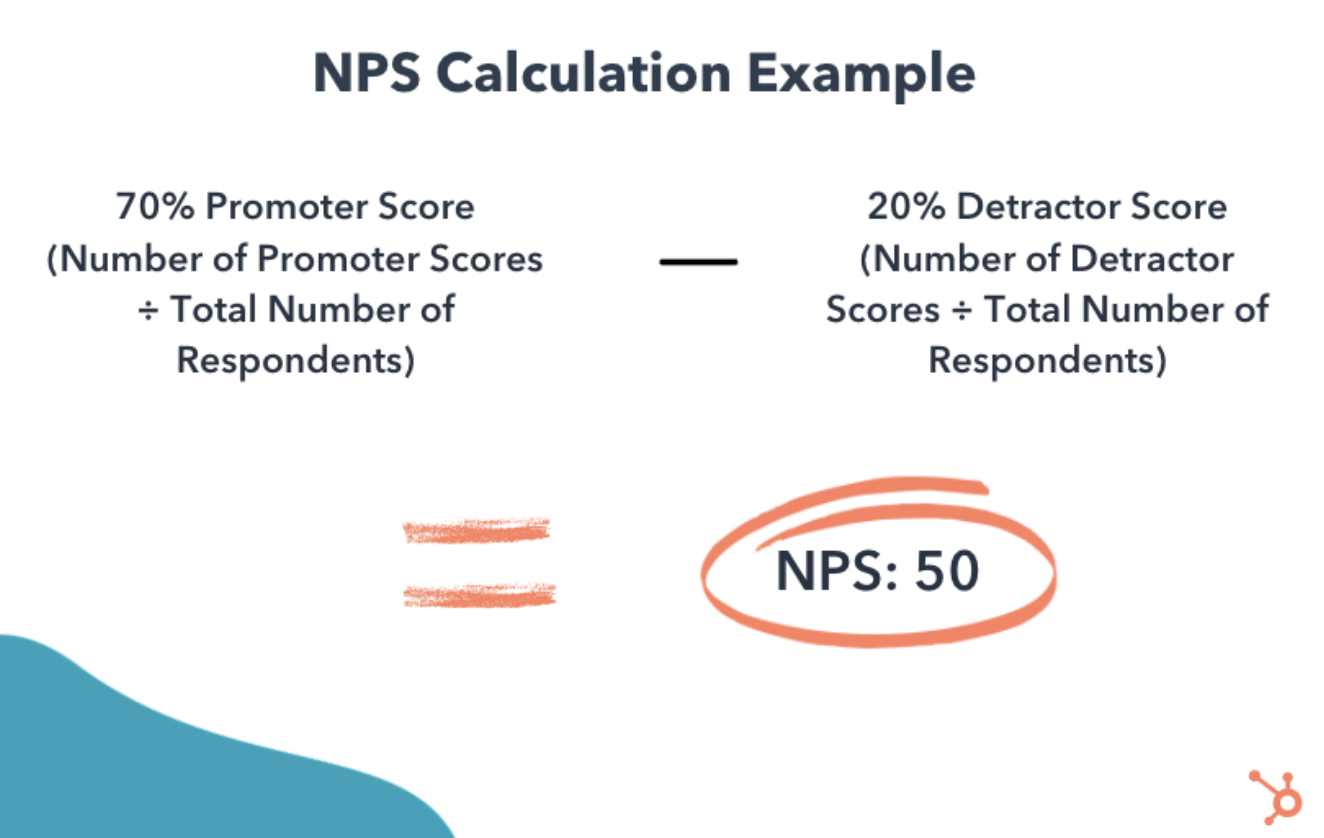
HubSpot also offers a Free NPS Calculator to help quickly identify your biggest fans or the individuals at risk of leaving and in need of a little extra TLC.
To gain a better understanding of why customers gave you the rating they did, provide a blank field for the customer to explain the reasoning behind it. This doesn’t affect your NPS, but it will give you a better understanding of what you’re doing right and where improvements can be made. (We'll dig into setting up NPS Survey questions and follow-ups in HubSpot later in this post.)
Your NPS will help you gain actionable insight into how you can cultivate better relationships with your customers, fostering an environment where customer loyalty thrives.
Tracking NPS also helps businesses keep a pulse on the quality of their service interactions, and often help in identifying trends that may require some attention.
Who should I ask to complete an NPS survey, and how often should the survey be conducted?
NPS surveys should be sent to customers who have been with you for at least 30 days, and a good rule of thumb for how often to ask your customers for this general feedback is once a quarter, or every 90 days.
The 30-day new customer period ensures they're more acquainted with your product, service, and company overall, and enables people to more accurately and wholly form overall sentiment of your brand.
Establishing a set NPS survey cadence ensures promoters stay happy, while also giving you the chance to regularly improve upon trends or gaps often noted within survey responses by passives and detractors.
A Guide to HubSpot's Net Promoter Score (NPS) survey tool
With Service Hub’s Net Promoter Score tool, teams can efficiently manage NPS surveys, easily choose people or groups to send them to, and automate tasks like presenting the customer with the customer with the survey when their contact record meets a specified criteria, or triggering workflows based on survey responses.
HubSpot’s NPS tool eliminates countless manual, tedious and time-consuming service to-dos and majorly simplifies customer feedback and sentiment collection. The NPS tool helps teams consistently and efficiently gather, track, and nimbly evolve to meet customer needs with some simple set-up.
How to create NPS surveys using HubSpot
To create an email or website Net Promoter Score (NPS) survey in HubSpot Service Hub with a Professional or Enterprise account, navigate to the “Service” tab, and click “Feedback Surveys”.
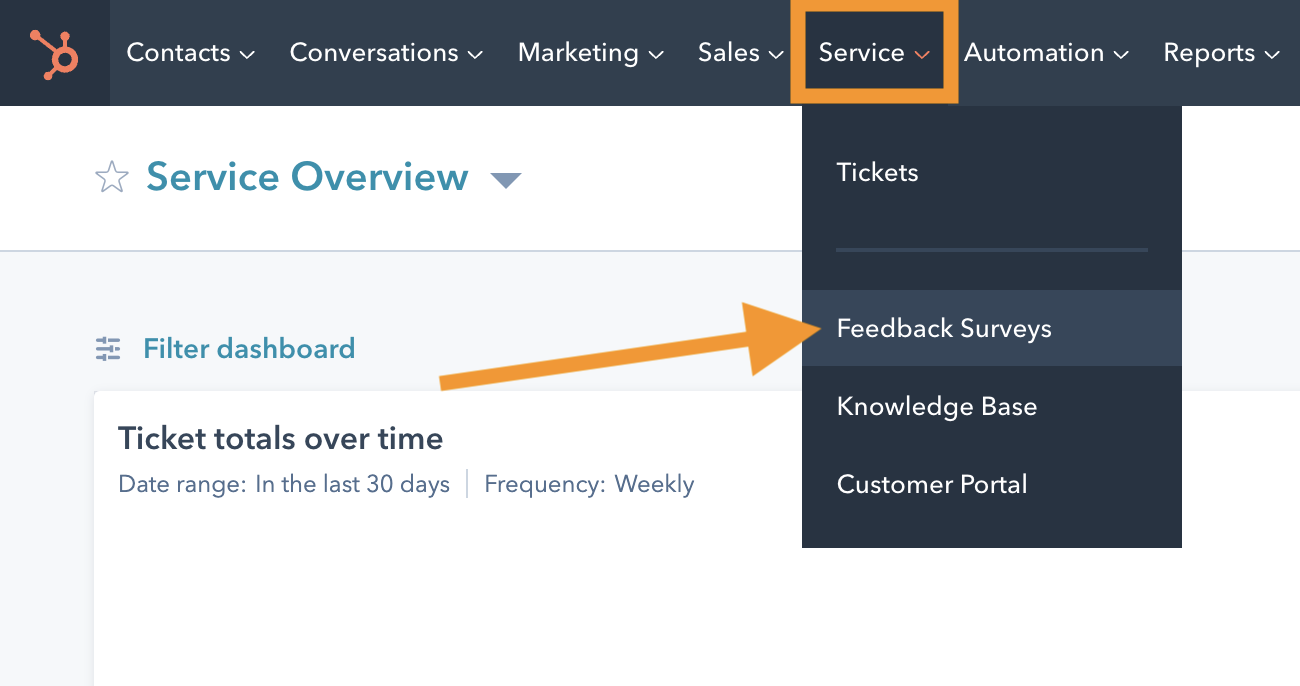

Once you’ve landed on the “Feedback Surveys” page, click on the orange “Create Survey” button in the top right corner. (It looks like this.) →
You'll then land on the "Choose a survey template" page where you'll select the “Customer loyalty” option located at the bottom left of your screen.
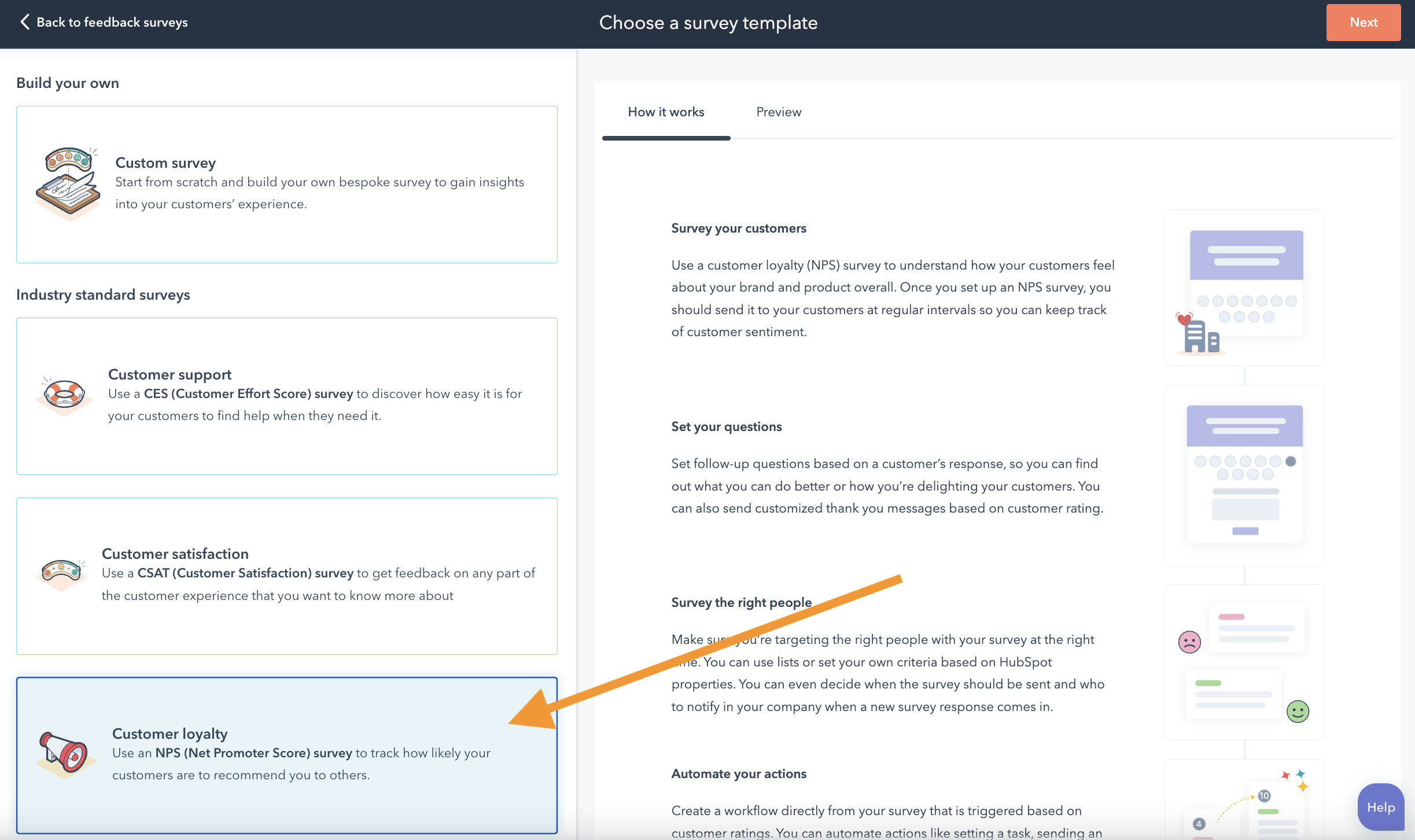
Once you’ve selected “Customer Loyalty”, hit the orange “Next” button in the top right corner.
On the next page, you'll have the option to “Choose [your] delivery method,” where you’ll select the type of NPS survey you’d like to set up; either website or email.
Setting up NPS Email Surveys in HubSpot
1. How to Create an NPS Email Survey in HubSpot
When presented with a website or email NPS survey option, select “Email,” then click the orange “Create” button in the top right corner.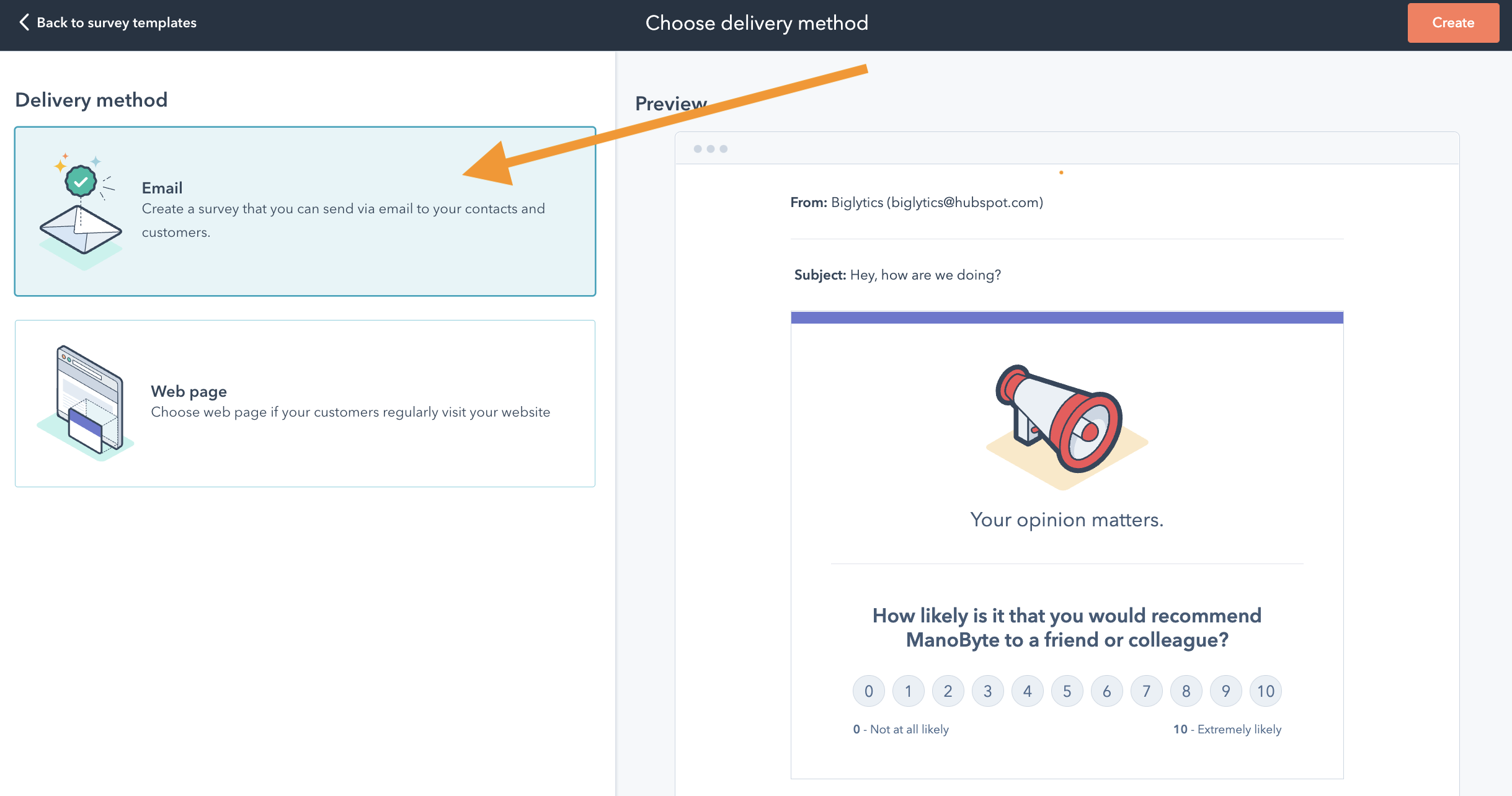
This action will take you to a page where you'll create and edit your NPS email survey's content and settings.
Within the “Survey” tab (which you’ll automatically land on when clicking into this page), look for and click on the “Email Settings” section on the left side.
Here, you’ll select survey language, enter your company name, the from address that will be shown as the email sender, and your subject line. 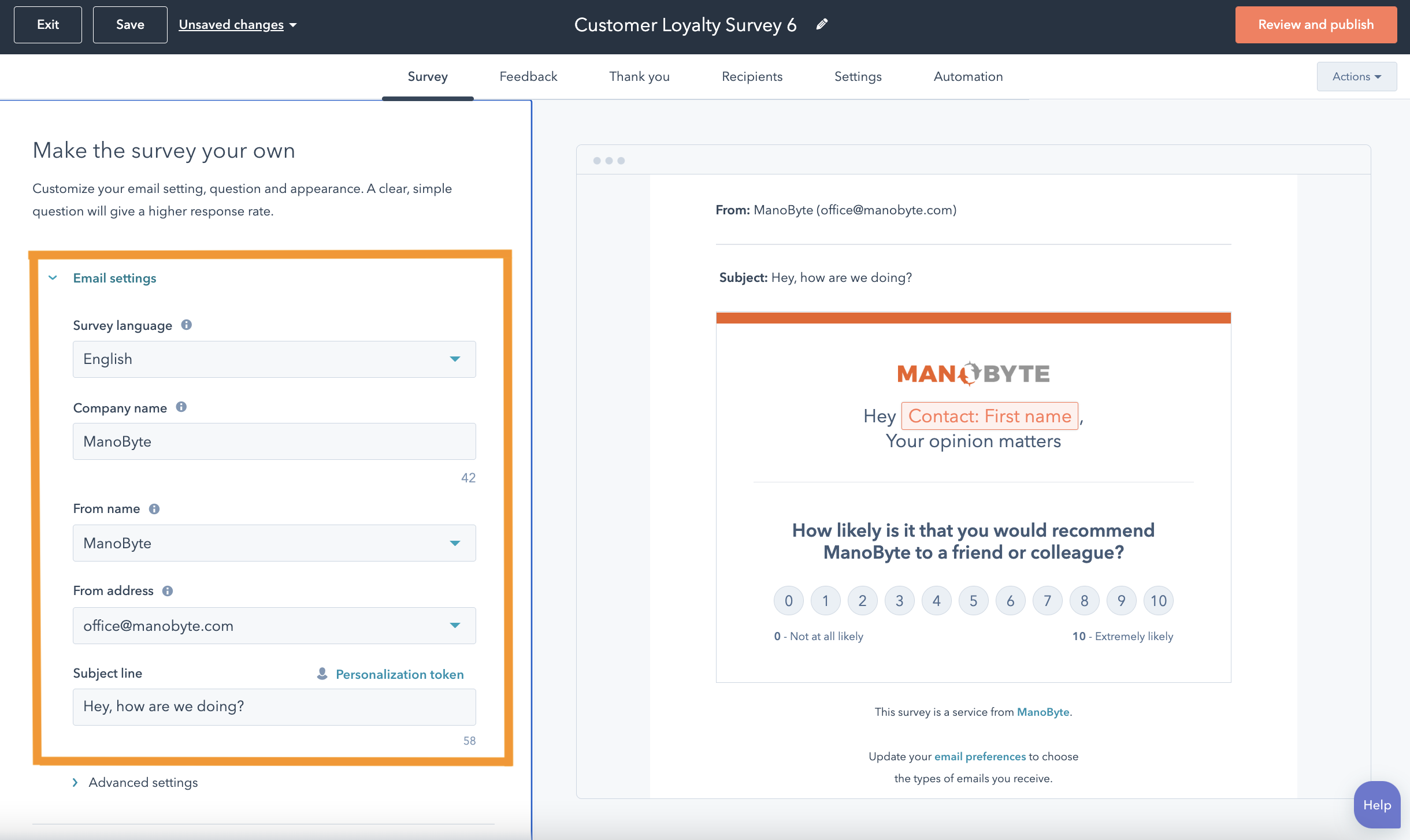
Wit
Process Organization tip: Once these fields are complete, you can click the “Email Settings” arrow to hide the settings you’ve completed. – You can also revisit and edit these settings at any time by simply clicking back on the arrow to drop the edit menu down, but if you’re a person who likes to get completed information out the way like me, this is a nice way of keeping things organized.
Next, under “Email Settings,” you’ll find and click on the “Email body” arrow to reveal the input fields where you’ll enter your email greeting.
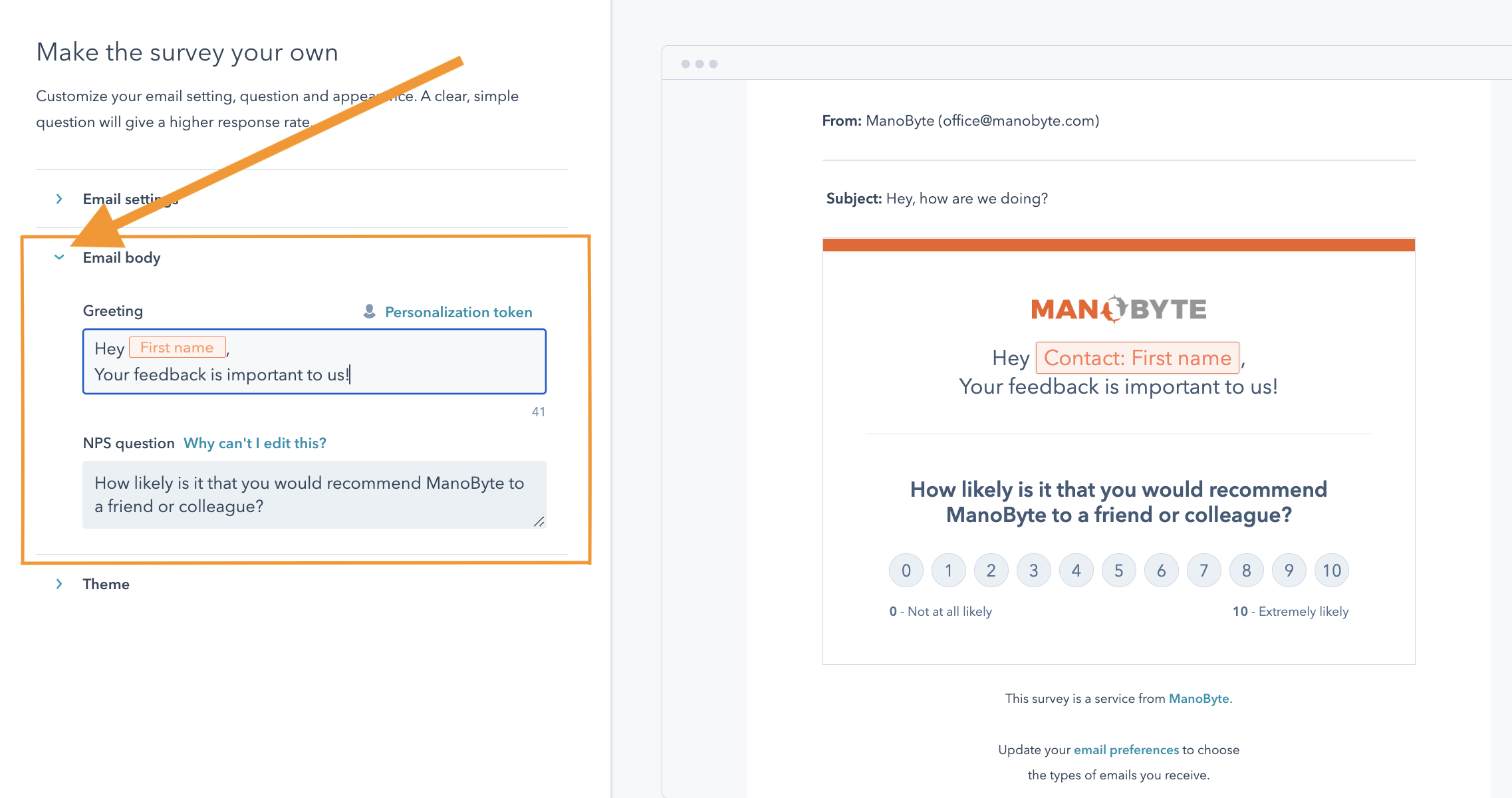
Add Personalization Tokens into the greeting where it makes sense.
For ours, we’ve included one that addresses the receiver by their first name.
We also recommend including something like, “We value your opinion,” or “Your feedback is important to us!”, to show appreciation for the customer taking the time to participate in your survey. (Remember to keep this section short and sweet!)
When you get to the “Email body” section, you’ll likely notice that it doesn’t allow for editing. This is because an NPS is an industry-standard survey, and measuring by the same benchmark allows for accurate comparison among your industry peers (as Service Hub will also point out to you within this section).
From here you’ll toggle down to the final “Theme” drop down on the left-side menu tab to personalize it in alignment with your brand.
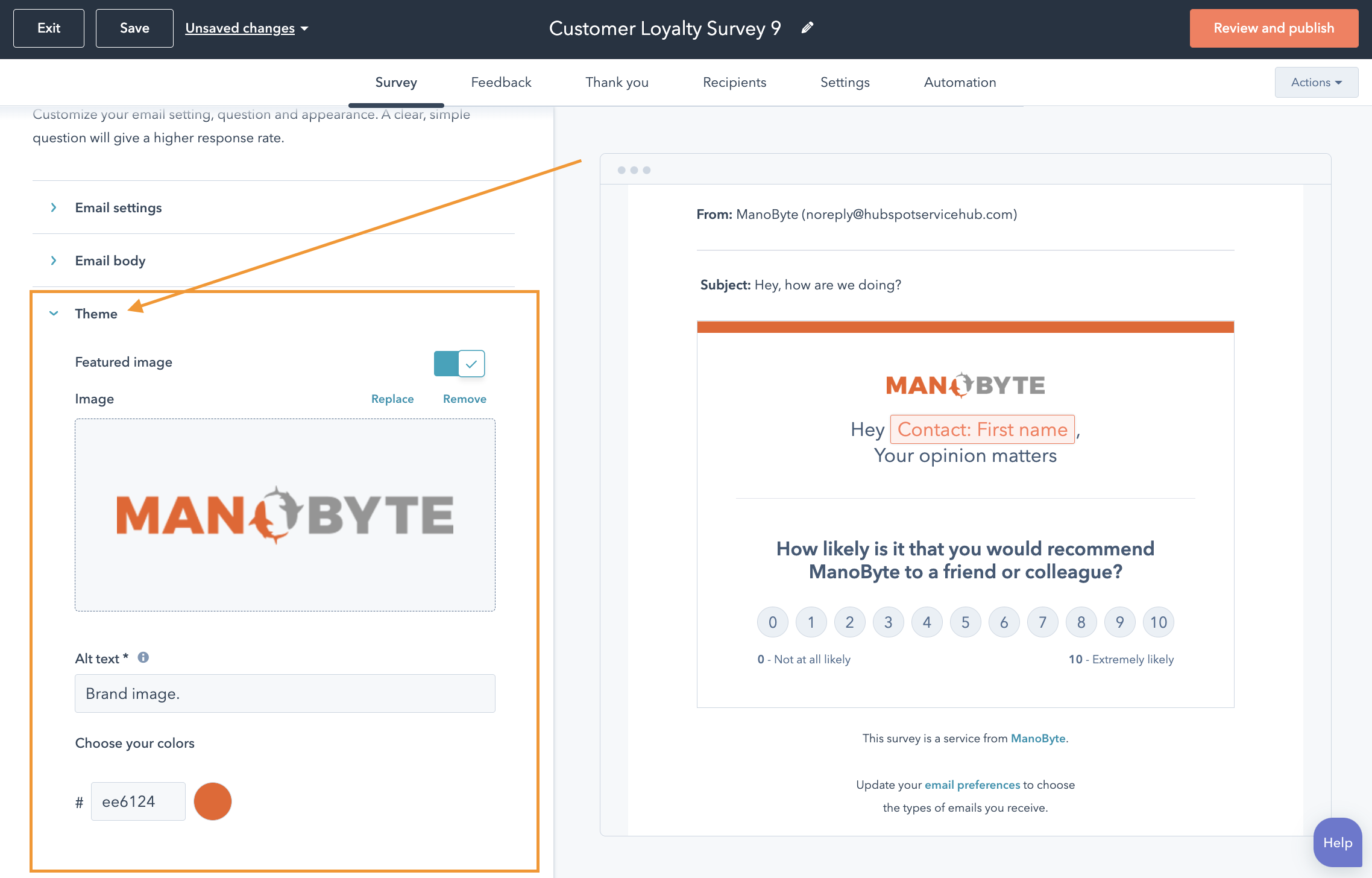
Add a featured image (this is typically your logo), your image Alt Text (which is read by screen reader software for the visually impaired, indexed by search engines, and also displays in the case of an image not loading), and your brand color.
Once you’ve customized your email body, head up to “Feedback” tab at the top, center of the page.
Here, you’ll set up questions that the user will be prompted to answer after giving you a specific score.
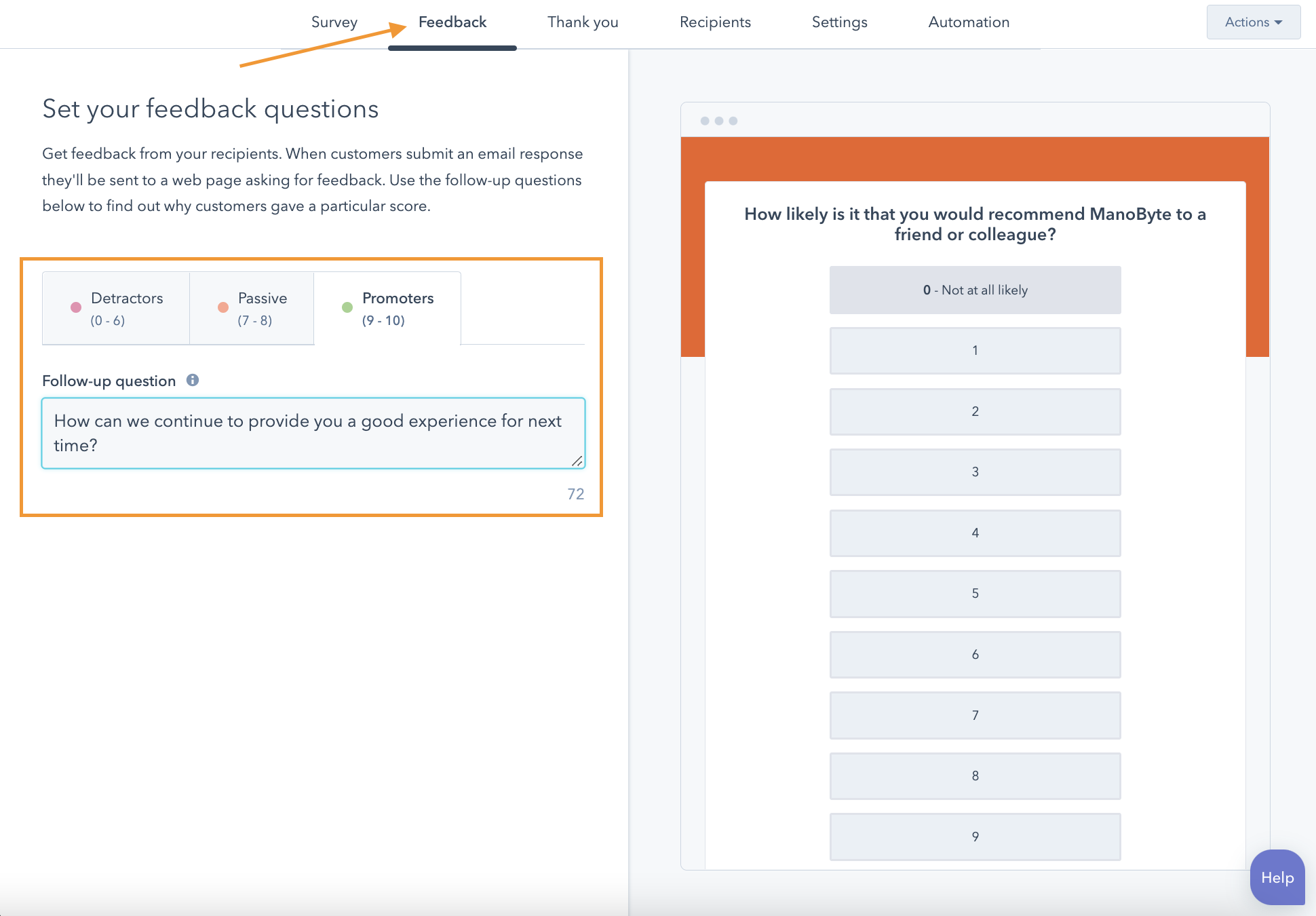
For Passive or Detractive level scorer questions (8 or below), offer a follow-up question like, “What’s one thing we can do to improve your experience for next time?”, or, “Can you tell us about your experience so we can do better/get it right next time?”
For your Promoters (9-10 ratings), follow-up questions may look like, "How can we continue to provide you with a good experience next time?”, or “Can you tell us why you scored us so highly?”
Now that you’ve set up your follow-up questions, head to the next tab on the page labeled “Thank you” where you’ll add in Image and Alt text to be displayed once the survey is completed.
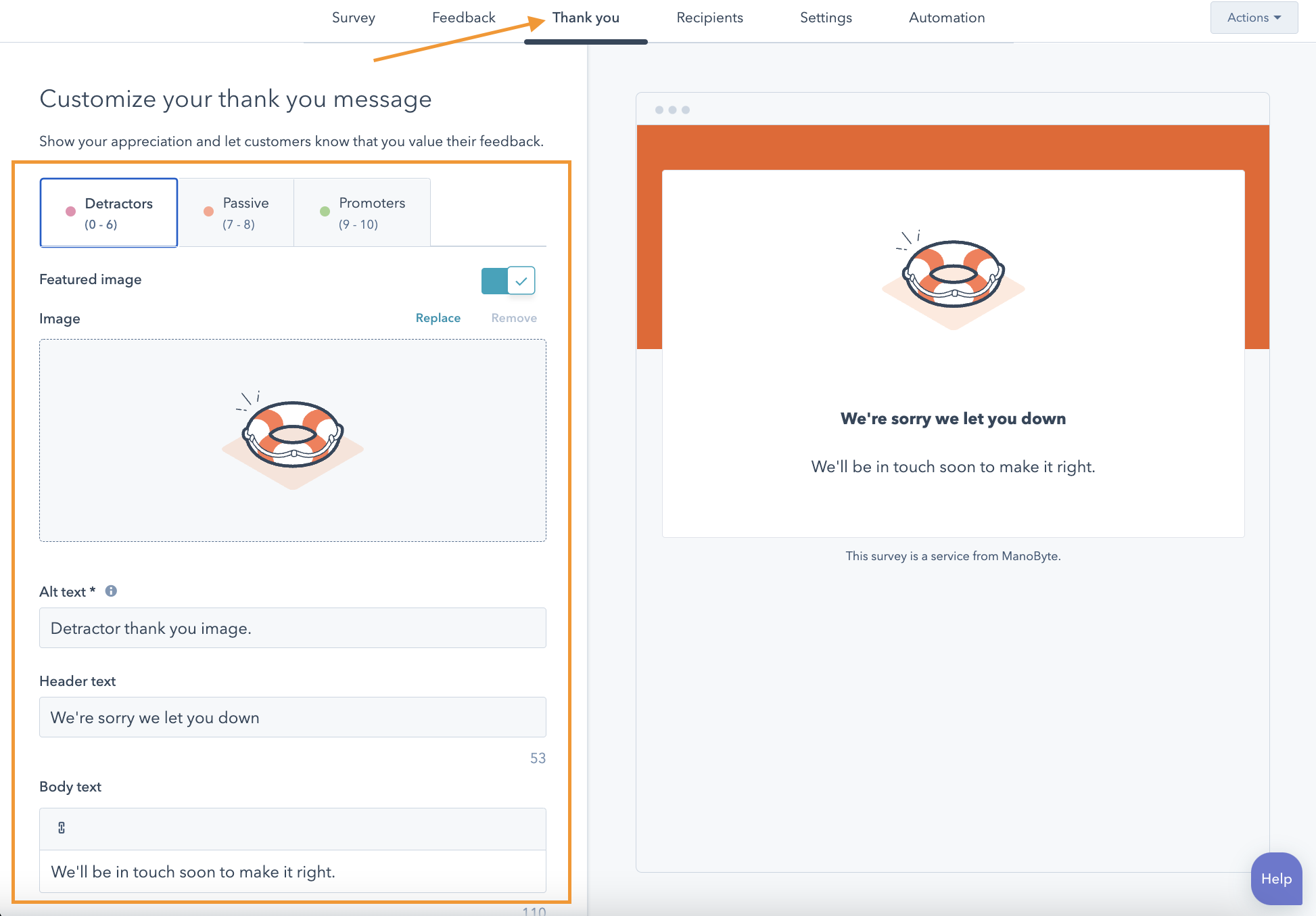
Add in an appropriate image for your Detractor level "Thank You's", as well as a Header and Body text in the input fields.
You’ll want to make sure your detractors know that you’ve received their feedback and are ready to make it right, and make it clear that you'll be in touch soon with your message.
Thank you’s should also be customized to reflect the given NPS, and an example of what the sender will receive post-review will again be reflected on the right side of the menu.
Fun (and Helpful) Fact: You can set up automation for specific score types that will trigger a notification informing your team of the score so they can reach out and address the issue one-on-one with the customer. (More on this later!)
Follow the same steps for your Passive and Promoter “Thank You's'' as you did for your Detractors, including appropriate images and text for each NPS level.
A header like “Thanks so much” with the body text “Your feedback means the world to us,” works well in both cases, especially when the language fits your brand tone and voice.
2. Selecting recipients for your NPS Email Survey
Now that you’ve created your survey, it’s time to choose which customers you'll be sending it to.
Head to the “Recipients” tab, and edit sender criteria to any given property or list within your fully integrated HubSpot CRM.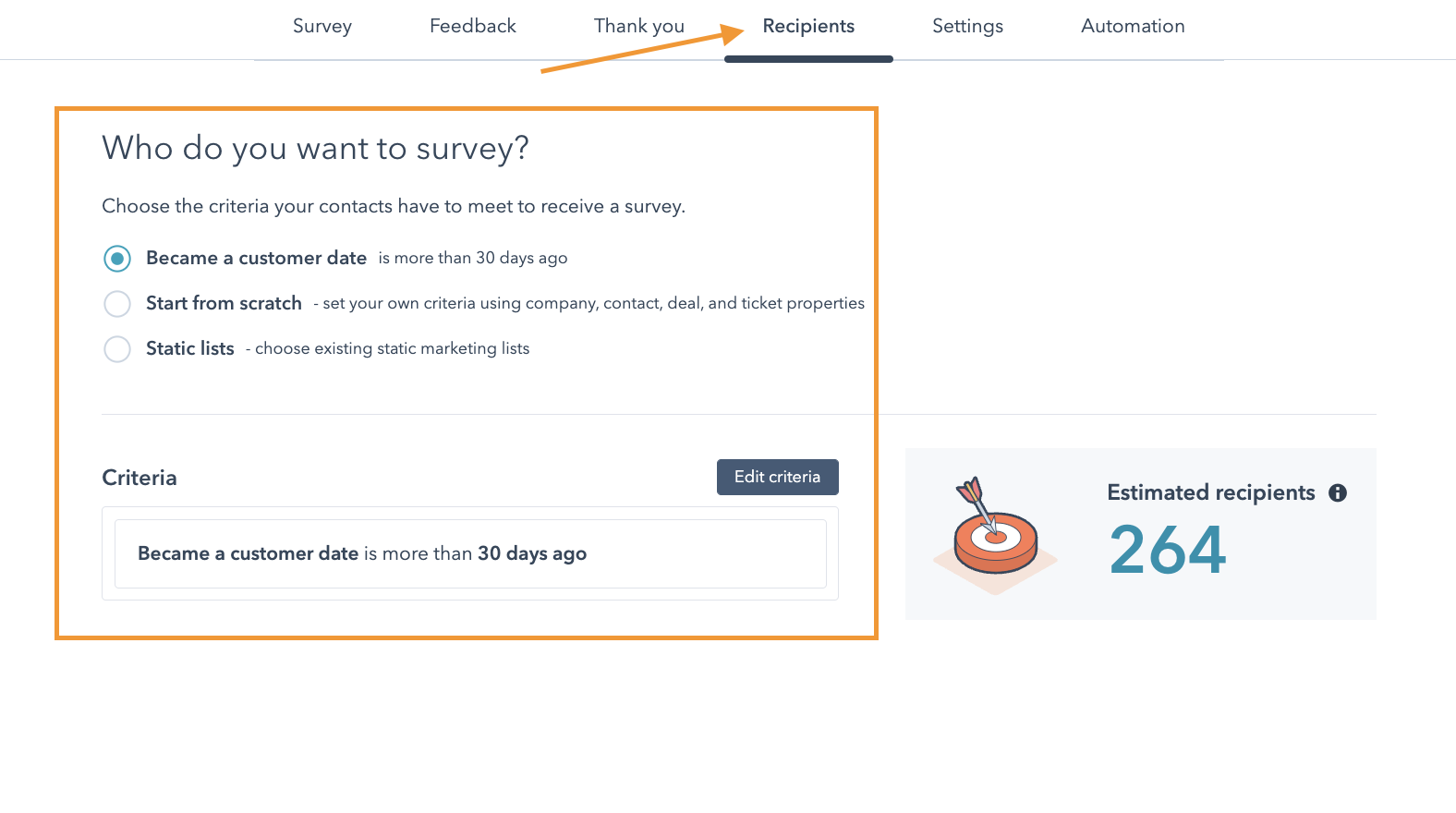 You can select any criteria (like that 30-day customer lifetime rule of thumb we discussed earlier in the post,) or any number of specified recipients or criteria-based lists here.
You can select any criteria (like that 30-day customer lifetime rule of thumb we discussed earlier in the post,) or any number of specified recipients or criteria-based lists here.
Now, how often will this list receive a NPS survey? Head to the “Settings” tab to set the cadence of your NPS surveys and when they’re sent.
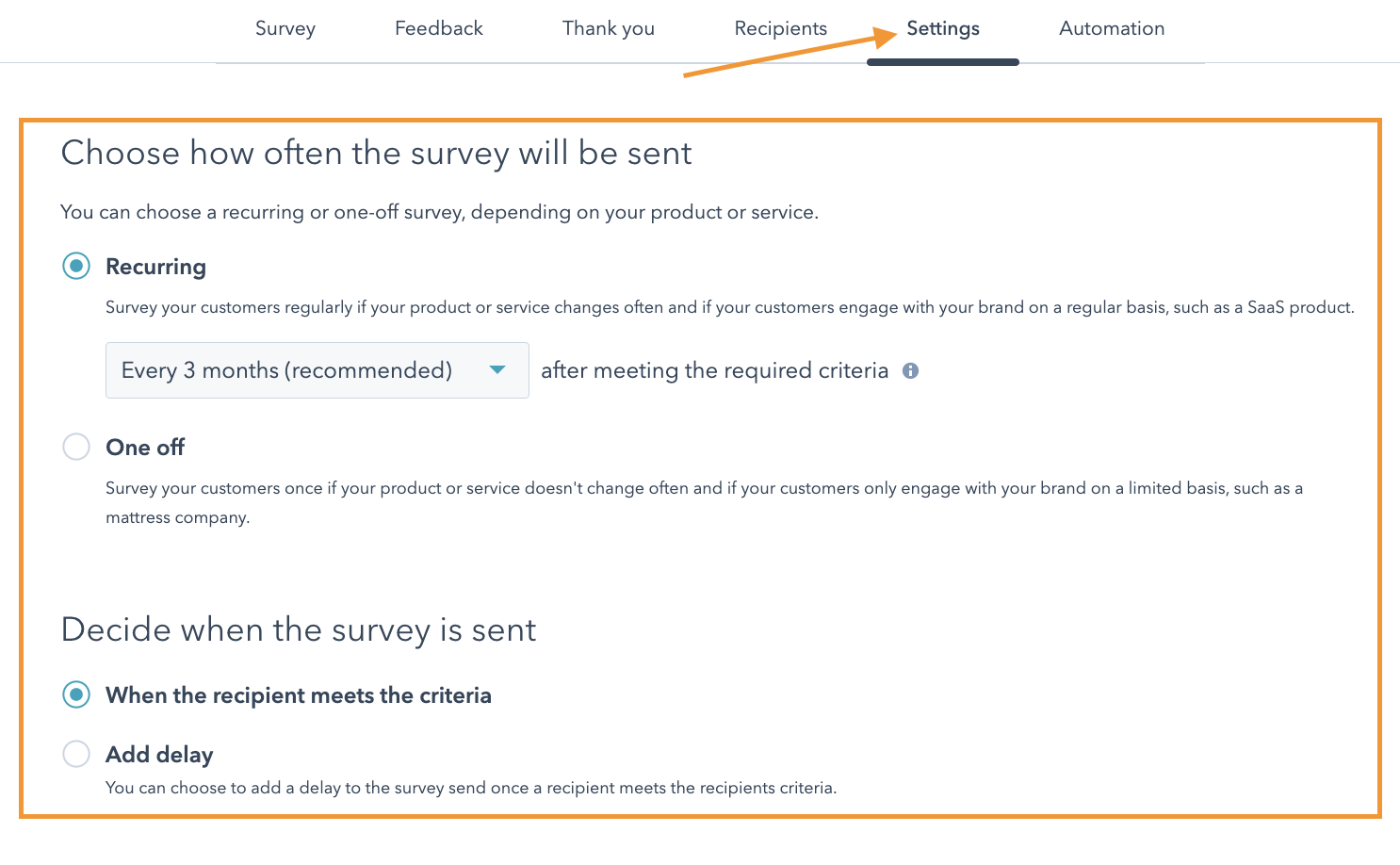 Once in “Settings,” choose how often you’d like to send the survey, and set any custom triggers. (Again, we suggest setting your NPS survey cadence to once every 3 months, or once per quarter.)
Once in “Settings,” choose how often you’d like to send the survey, and set any custom triggers. (Again, we suggest setting your NPS survey cadence to once every 3 months, or once per quarter.)
Now we’ve reached the final “Automation” step. Click this tab to customize any follow-up actions or triggers based on the given NPS survey score.
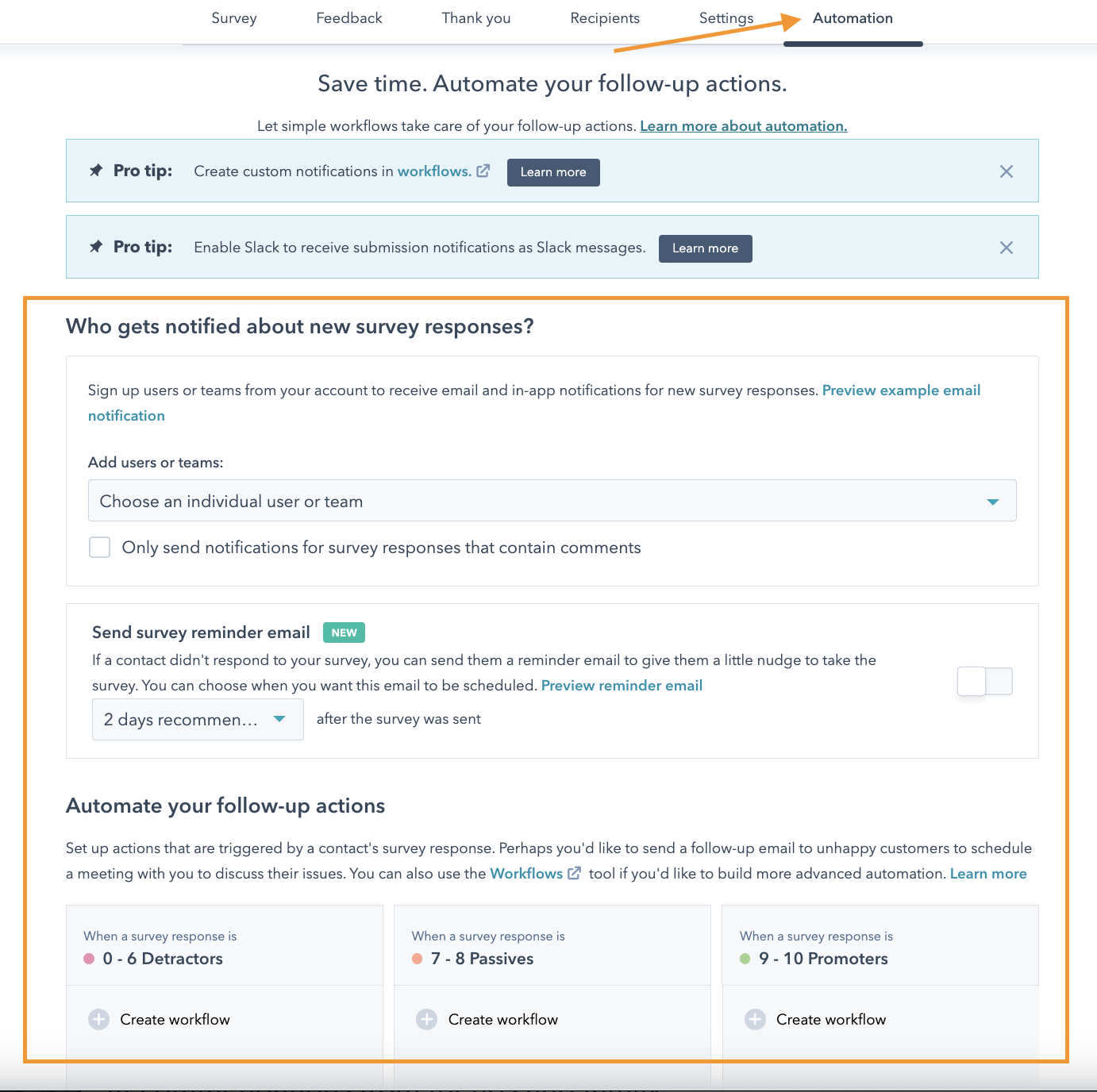
You can select teams or individual users to be notified as-needed for each NPS score level, set up a cadence for recipient survey reminder emails in case your customer received the email but hasn’t yet completed the survey, and create actions that trigger notifications for your team to reach out and work to resolve the issue with the customer.
For more advanced automation, you can also create custom Workflows, which you can learn how to set up by clicking the "Workflows" link in the “Automate your follow-up actions” section.
Now it’s time to take your survey for a test run! Head to the “Actions” drop-down in the top right and select “Preview” to see what it will look like to the receiver. This page will enable you to view how the survey will look when viewed from a desktop, a tablet or a smartphone, and is automatically optimized by Service Hub for each respective device.
If you’re like me and prefer to also receive the email yourself to make sure it’s perfect before sending it to your customers, you can also select “Send test survey” from the “Actions” tab.
Want another set of internal eyes on your survey before sending it to customers? No problem. You can also select any teams or team members to receive the test email, and even if you or they click a score and respond to the survey in the test email, we can assure you that the test will not collect any data, trigger any notifications or workflows, or mess anything up. So, test freely, friends!
Once your email is set up and deemed perfect, send that bad boy by clicking “Review and Publish”.
Look over your details and make any final edits, and when you’re ready, hit “Publish”.
Setting up NPS Website Surveys in HubSpot
1. How to create a NPS Website Survey in HubSpot
Creating a website-based NPS survey in Service Hub is nearly identical to setting up one via email.
If you don't recall how to get to your NPS survey delivery method page, head back up to the first steps in this post under “How to Set Up Net Promoter Score(NPS) in HubSpot”, simply select “Web page”. From there, click the orange “Create” button in the top right corner.
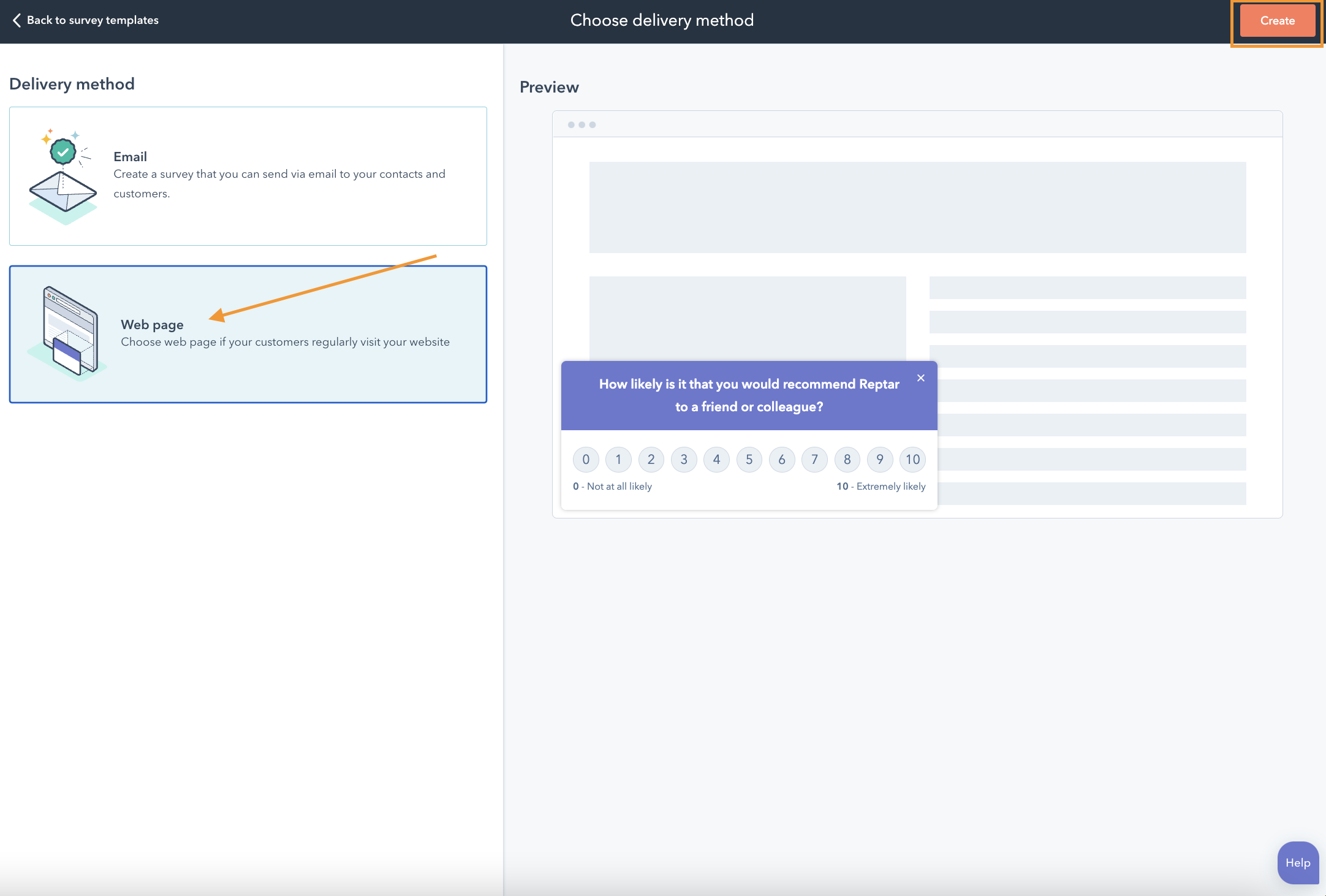
When you reach the next page, you’ll automatically land under the first "Survey" tab listed at the top of the page.
Just like the email NPS survey, choose language and company name under the “Survey” toggle on the left-hand menu.
Once completed, head to and select the second “Position” toggle.
You can choose the location of your survey on your website, as well as whether or not you’d like the full “Slide-in [survey] box” to pop up right away to gather user attention and prompt a quick and easy response.
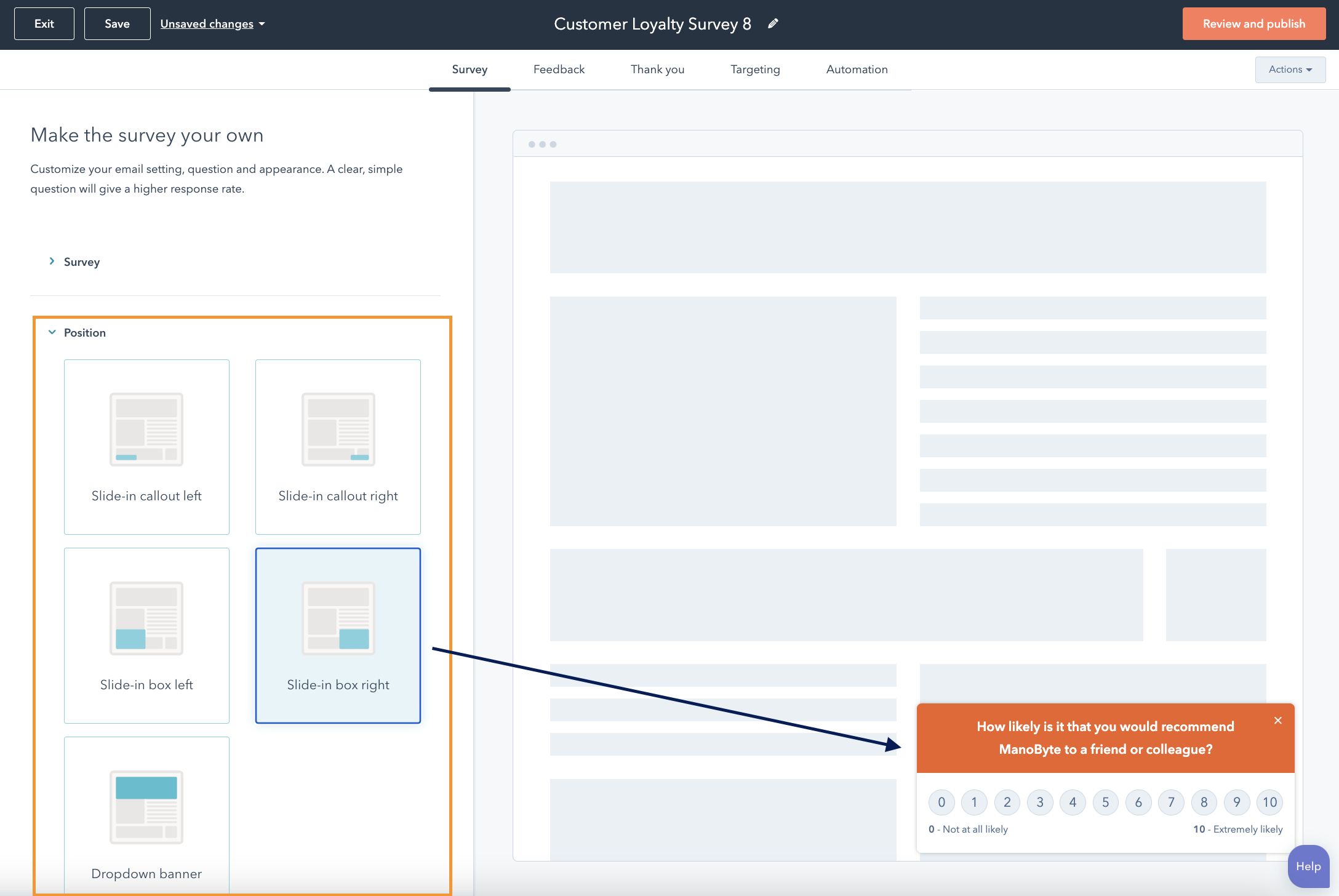
You can also select one of the “Slide-in callout” options that pops a “Would you recommend us?” box in the bottom corner of your website.
With this option, the NPS survey will pop up and prompt a response only if your website user clicks on the question that pops up in the corner.
Example below: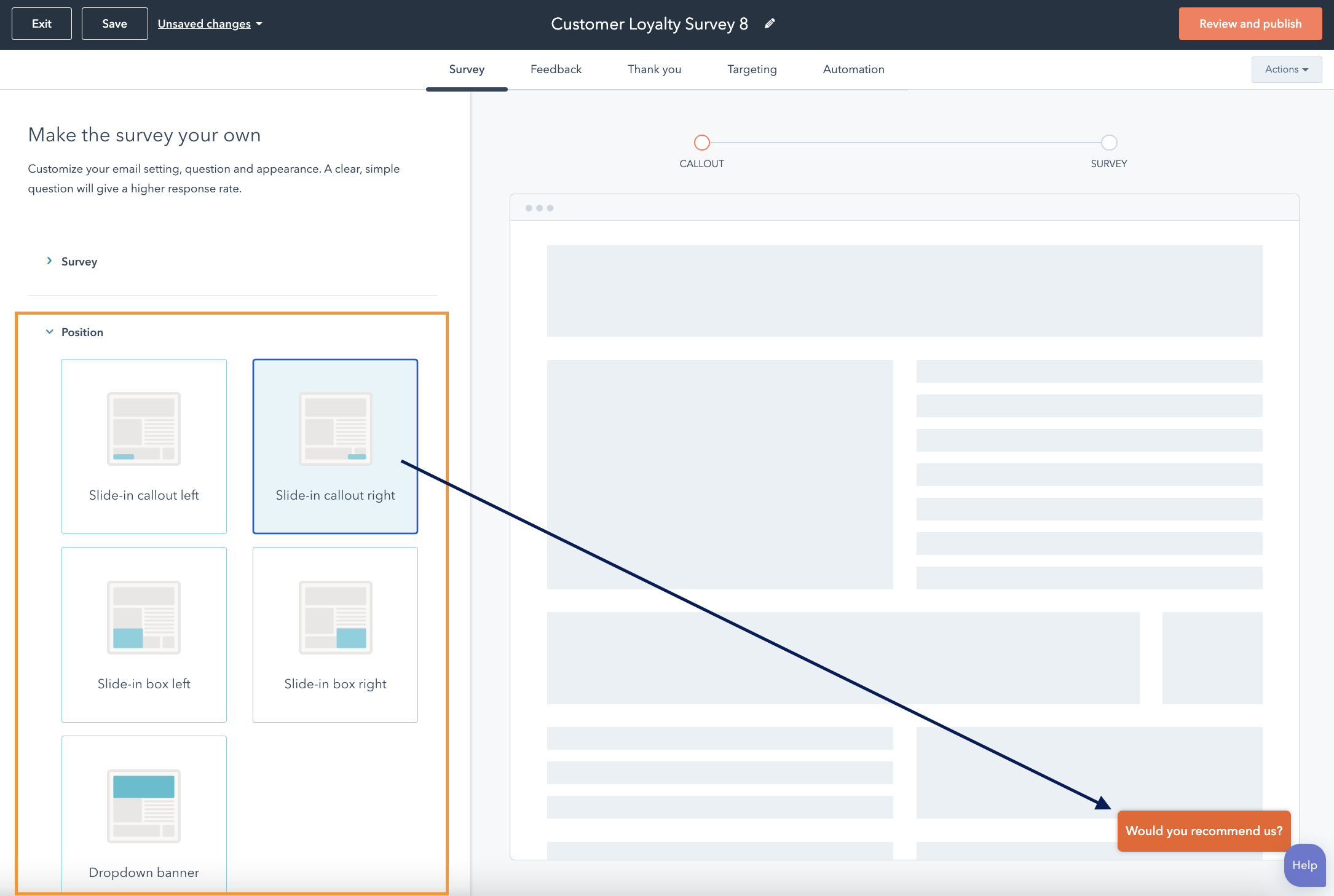
The position and how your NPS survey is displayed on your website is truly a personal preference thing and either are great great options!
Here a tip: If you’re not sure which NPS survey prompt to choose, you can always try one for a set period of time, then the other, and track and compare metrics to see if one yields a better response rate than the other.
Once you’ve selected your position, toggle down to the final “Theme” section within the Survey’s left-side navigation and select your brand color.
Now, click the “Feedback” tab at the top of your NPS Survey page. Just like with the email survey, you’ll want to make sure that your follow-up questions are customized to the score given to you by the user.
Note: If you missed this earlier and are looking for different follow-up tips for Promoters, Passers and Detractors, scroll up to the image with the arrow pointing to “Email Feedback” in the Email NPS Survey section and read the text below.
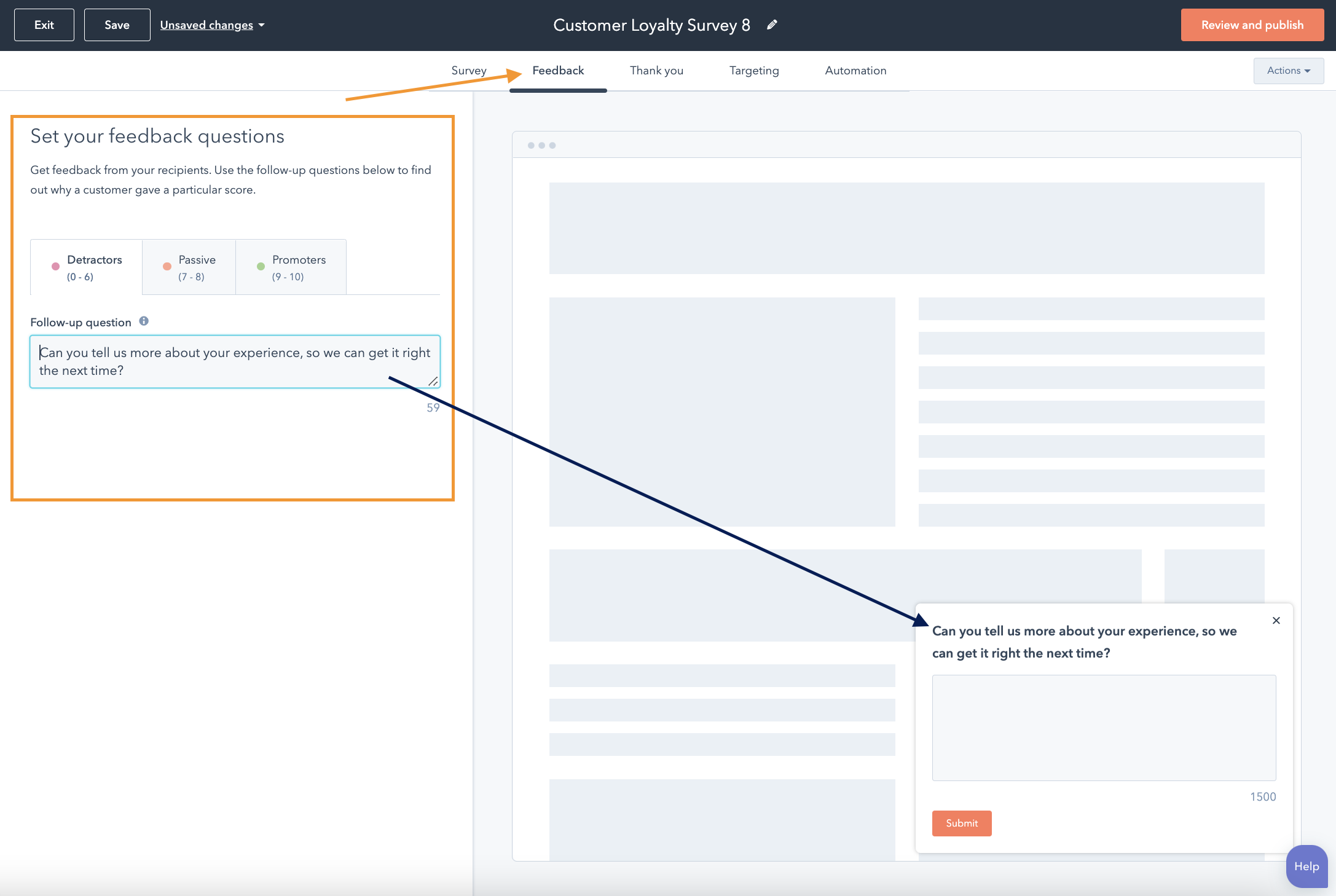
Again, your copy for each respective score that the user will see on your website will be reflected in the example on the right-hand side of the page, as displayed above for “Detractors” .
Next, navigate to the “Thank you” tab at the top and center of the page.
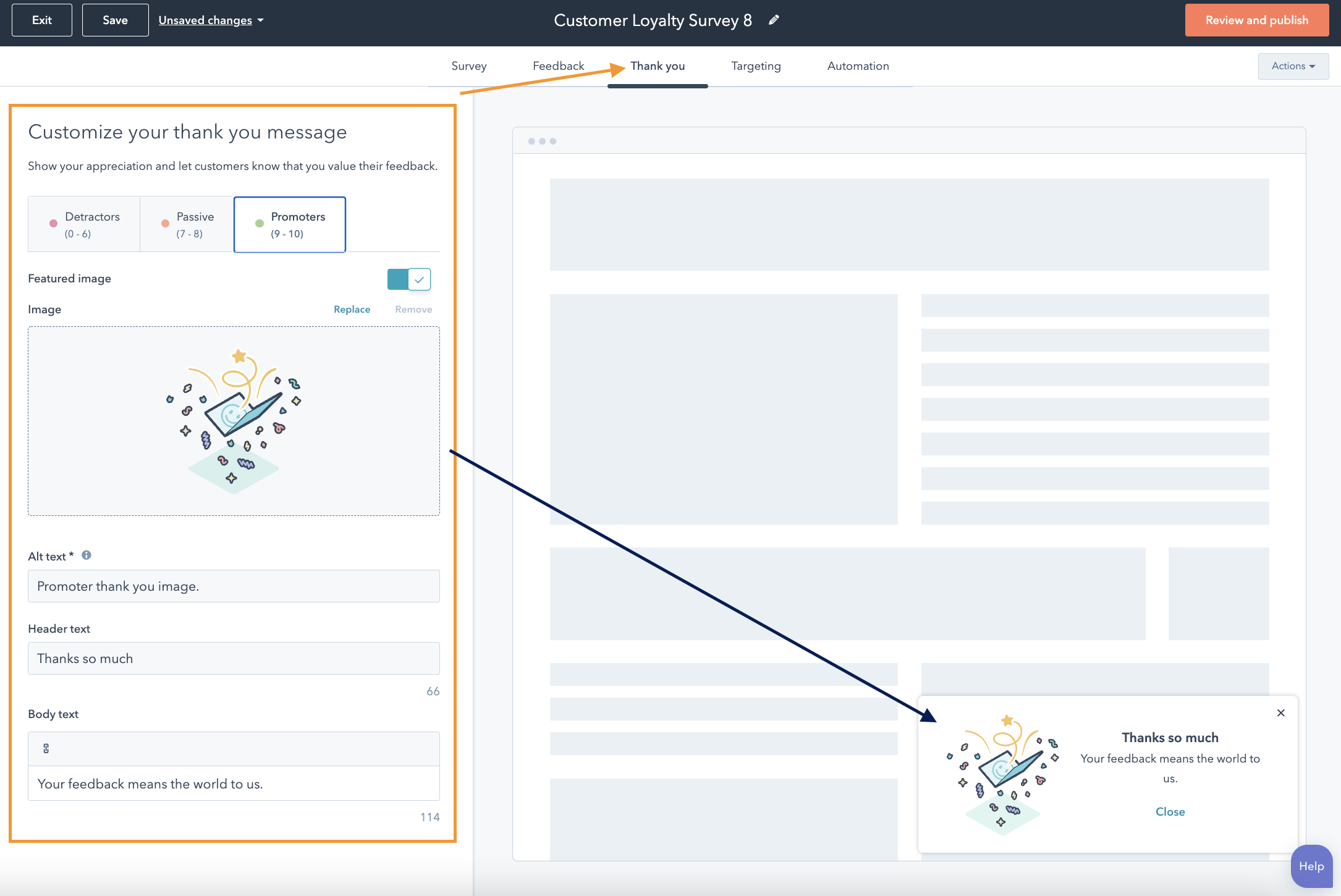 .
.
From there, select an appropriate Image, include Alt text, and enter your message header and body into their respective input fields.
Again, to re-visit tips on what to write for each NPS score, head this time to the image pointing to the “Thank you” tab under the NPS Email Survey Setup section and follow the same guidelines.
Next, click the “Targeting” tab, which will allow you to choose who does, or doesn’t see the survey on your website.
With Service Hub fully integrated into HubSpot’s CMS and free CRM tool, your website will have a contact record associated with each user, allowing you to target specific customers who have either been with you for at least 30 days, those on a specific list within your CRM, or even specific contact, company, deal, ticket, or other property associated with their contact record.
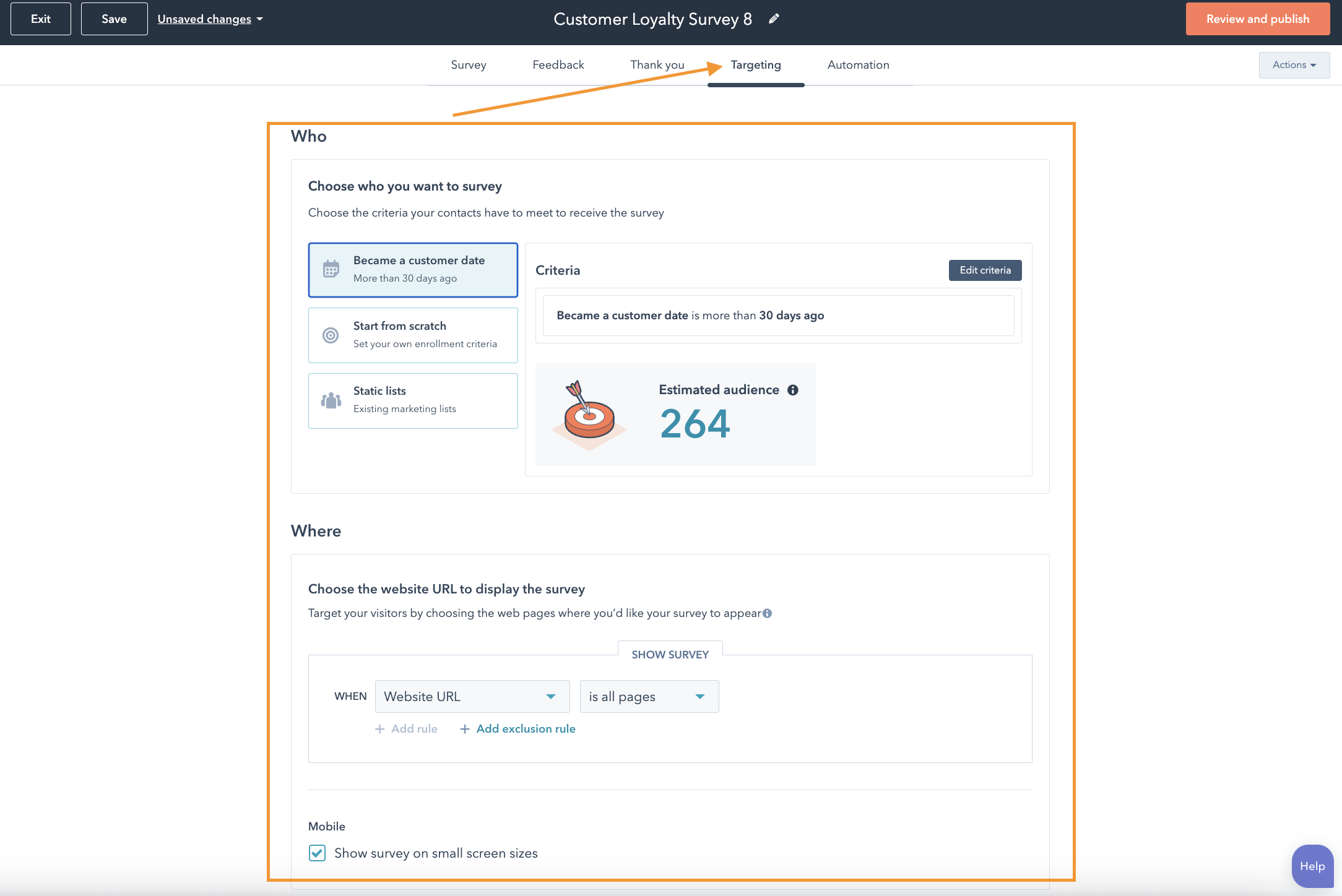
You can also select whether or not you’d like the NPS website survey to pop up on your site when displayed on a mobile device, as well as when the survey will pop up on the page and the survey frequency.
Now head to the “Automation” tab to complete your final step of setting up your NPS website survey.
Just like the NPS Email Survey setup, you’ll be able to automate specific follow-up actions or trigger workflows for each response type (Detractors, Passives and Promoters) as you'll see below.
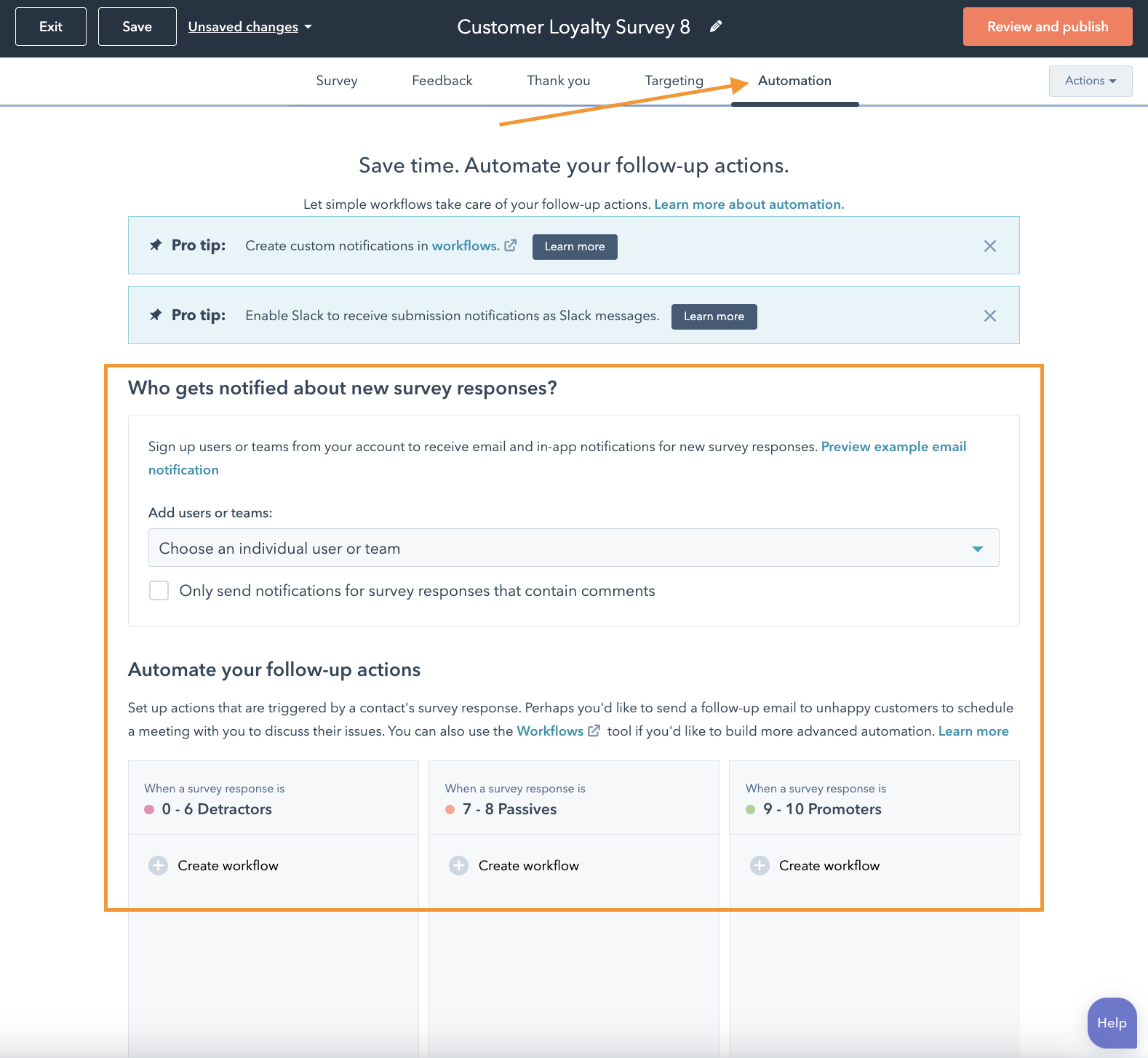
Finally, make sure to take your survey for a test run by clicking on the “Actions” drop down in the top right corner and selecting your test method of choice from there.
Click "Preview" see how the survey will look on the three given devices, or hit “Test Survey” to take it for a spin on your website.
Congratulations! You’re now a Service Hub NPS Survey Pro!
The customer-first mentality is the cornerstone of making sure your business thrives in today’s unpredictable market. By regularly collecting, analyzing and responding to customer feedback, you keep an open flow of communication that helps ensure your customers remain happy and keeps your flywheel spinning; helping your business to grow better.
Service Hub’s Net Promoter Score (NPS) email and website survey creation tools enable businesses to easily track and manage customer sentiment to ensure their customers are (and stay) - happy.
Ready to find out what your customers think about your business but not sure if Service Hub is the right choice for you?
HubSpot offers a free version of Service Hub that is also fully integrated with HubSpot’s (also free) CRM so you can kickstart your customer-first journey towards strategic business growth.
Still have other lingering questions? We’ve got you.
ManoByte is a HubSpot Agency Partner, and one of HubSpot’s leading Service Hub implementation and consulting experts. Our friendly, knowledgeable team is here to help you every step of the way.
Ready to Dive In?
Work with our team of Business Process experts and watch us take manual clunky systems, tech stacks, and processes and turn them into tailored, intelligent workflows that deliver business outcomes.


